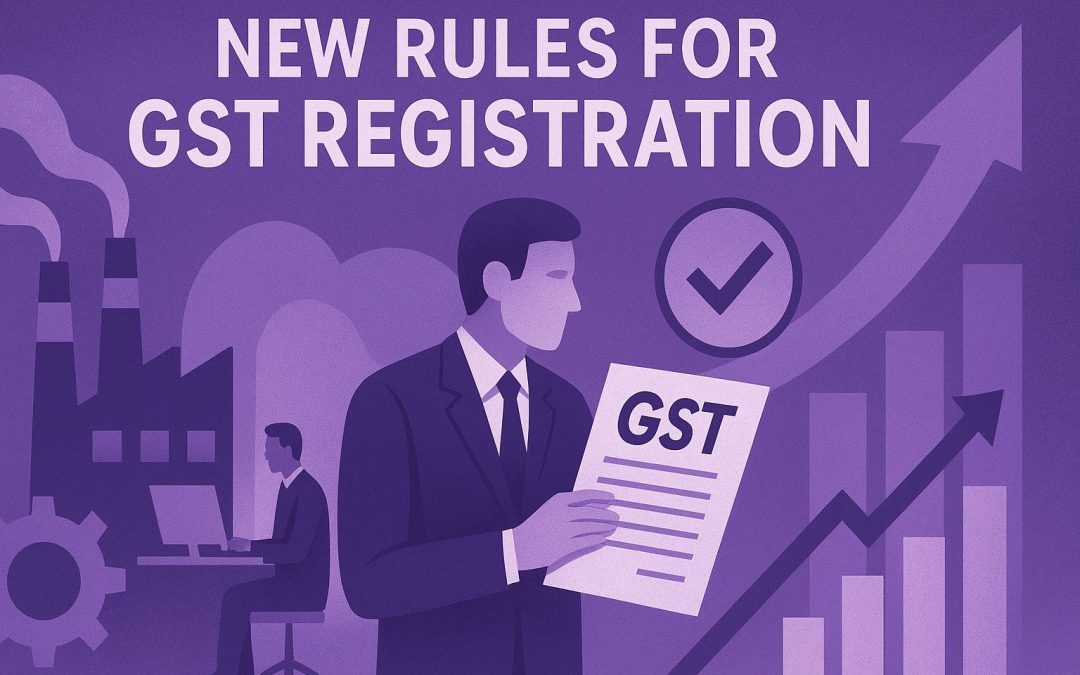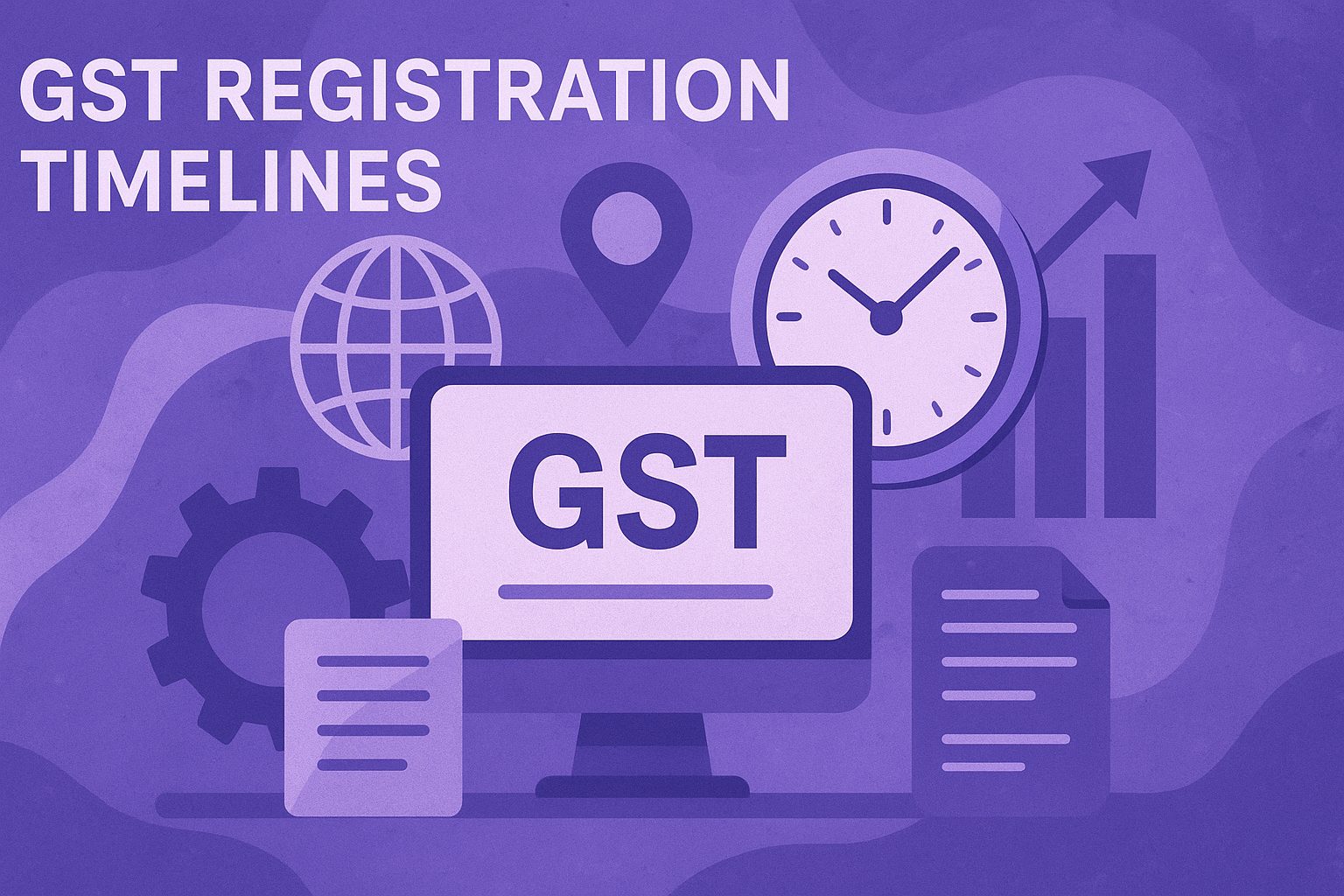Table of Contents
The government has strengthened the GST registration framework to make it more transparent, efficient, and resistant to fraud. Under the latest amendments to Rule 8 of the CGST Rules, biometric-based Aadhaar authentication has been introduced for new GST applicants, alongside risk-based verification and state-wise rollout of facilitation centres for in-person document and photo verification.
Applicants can now complete biometric verification in their home state instead of travelling to the jurisdictional GST office, simplifying the process for startups and MSMEs. Updated verification timelines have also been introduced – applications verified through Aadhaar may be approved within three working days, while those flagged for biometric checks follow extended timelines. These reforms, supported by data-driven risk profiling, aim to curb fake registrations and input tax credit misuse. The updated rules affect all categories of businesses, from emerging startups to large enterprises, making it essential for business owners to stay informed and compliant with the revised GST registration process.
This article explains the key updates to GST registration, their impact on businesses, the step-by-step registration process, and how enterprises can ensure full compliance under the 2025 regulatory framework.
Also read: What are the different types of GST registration?
How Does Biometric Authentication Work While Registering?
Biometric authentication in GST registration verifies an applicant’s identity using Aadhaar-linked fingerprints, iris scans, and live photographs, ensuring secure and fraud-resistant verification for new business registrations.
What Is the New Biometric Authentication Facility?
Until early 2025, individuals applying for GST registration in a state different from their residence had to travel to that specific state for biometric verification. This often caused delays and added costs, particularly for MSMEs, startups, and expanding businesses operating across states.
As per the CBIC and GSTN updates implemented from February 2025, business owners can now complete their biometric Aadhaar authentication in their home state, even when registering in another state. The facility, rolled out through designated GST Suvidha Kendras (GSKs) across India, simplifies the registration process and prevents the misuse of fake or duplicate GSTINs.
Must read: GST State Code list and jurisdiction (2025): Purpose, use, how to find
Steps for Completing Biometric Authentication?
The biometric authentication process under the new system follows a simplified, step-by-step approach:
- Visit a GST Suvidha Kendra (GSK): Business owners must visit their nearest GST Suvidha Kendra in their home state for authentication.
- Submit Aadhaar & Business Documents: Applicants must provide their Aadhaar number, business registration documents, and proof of address.
- Undergo Biometric Verification: The authentication includes fingerprint scanning, iris recognition, and facial identification.
- Receive Authentication Approval: After verification, businesses will receive authentication approval within a few days, enabling them to proceed with GST registration.
Why Is Biometric Authentication Beneficial for Businesses?
No Inter-state Travel: Applicants can now verify identity locally, reducing travel time and expenses.
Faster Processing: Aadhaar-based verification enables quicker GSTIN approval; often within three working days for non-flagged applications.
Improved Security: The biometric system minimises fraudulent or duplicate registrations by ensuring that each GSTIN is tied to a verified individual.
How Does the New Biometric Authentication Process Compare to the Old One?
Previously, business owners had to undergo manual verification in the registering state, often facing delays due to administrative backlogs. The new process provides a centralised and standardised approach, reducing verification time and simplifying compliance.
Where and How Can You Complete Biometric Verification?
To complete biometric verification, applicants should:
- Visit their nearest GST Suvidha Kendra with the required documents.
- Complete Aadhaar-based authentication with fingerprints, facial recognition, and iris scanning.
- Ensure their details match their business registration records to avoid delays.
Why Is Aadhaar Authentication Now Mandatory for GST Registration?
Aadhaar authentication has become a core requirement in the GST registration process to prevent fake or fraudulent registrations, ensure genuine businesses, and improve compliance efficiency. The authentication links the applicant’s unique Aadhaar ID to their GSTIN, strengthening the verification framework and reducing tax evasion risks.
What Are the Requirements for Aadhaar Authentication?
Since February 2025, Aadhaar authentication is mandatory for all new GST registrations, except for specific exempt categories such as non-resident taxable persons, foreign companies, or government departments. Applicants flagged as “high-risk” by GSTN’s analytics system must also undergo biometric Aadhaar authentication at a facilitation centre (GSK) before approval.
How Can You Complete Aadhaar Verification for GST Registration?
- Provide Aadhaar Details: Enter the Aadhaar number during the GST registration process.
- OTP-Based Authentication: An OTP (One-Time Password) is sent to the registered mobile number linked with Aadhaar.
- Biometric Verification: The applicant completes fingerprint or facial authentication at the GST Suvidha Kendra.
- Approval Confirmation: Once authentication is successful, the GST registration process continues without delays.
Why Is Linking Aadhaar Important for GST Registration?
- Prevents Fraudulent Registrations: Ensures that only genuine businesses obtain GSTIN.
- Strengthens Identity Verification: Links the GST account to the business owner’s unique Aadhaar identity.
- Enhances Compliance & Accountability: Reduces cases of fake registrations and shell companies.
How Does Aadhaar Authentication Prevent Fraudulent GST Registrations?
Before Aadhaar authentication became integral to GST registration, fraudulent entities often used fake identities or duplicate documents to secure multiple GSTINs. With the 2025 update, Aadhaar and biometric verification are mandatory for flagged or high-risk applications, making such frauds nearly impossible. Each GSTIN is now traceable to a verified Aadhaar identity, backed by biometric validation and risk-based scrutiny through GSTN’s analytics engine.
What Happens If Aadhaar Authentication Fails?
If Aadhaar authentication fails due to technical errors, mismatched biometrics, or incomplete data, the applicant’s case is referred for physical verification of business premises by the jurisdictional GST officer. Only after successful verification and approval can the GSTIN be issued.
What Are the New Verification Timelines for GST Registration?
To improve efficiency and reduce waiting times, CBIC has revised the verification timelines (Effective since February 2025):
- Aadhaar-authenticated applications: Deemed approved within 3 working days if no notice is issued by the officer.
- Biometric or non-Aadhaar cases: Must be verified within 21 working days from the date of submission.
- Additional time (7 working days) may be granted if clarification or further verification is required.
These stricter, time-bound rules ensure faster processing and greater transparency in GST registration.
What Happens If You Miss the GST Verification Deadline?
Failure to complete Aadhaar or biometric authentication within the stipulated timeline may result in:
-
Automatic rejection of the GST application.
-
Re-application requirements, with fresh document uploads and verifications.
-
Delays in tax registration and compliance, affecting business operations.
How Will the New Verification Timelines Impact Businesses?
With shorter and clearly defined verification timelines, businesses can now secure GSTIN approval within a week in most cases, significantly faster than earlier processes. This allows quicker commencement of operations and reduces administrative delays, particularly benefiting MSMEs and startups.
Comparison: Old vs. New GST Verification Process
| Parameter | Before Feb 2025 | After Feb 2025 (Current) |
|---|---|---|
| Aadhaar Authentication | Optional for some applicants | Mandatory for all new applicants (with exceptions) |
| Biometric Verification | Required only in the registration state | Can be completed in home state GSK |
| Approval Timeline | Up to 30 days | 3–7 working days (Aadhaar) or up to 21 days (biometric) |
| Fraud Detection | Manual scrutiny | Risk-based, data-driven verification |
| Travel Requirement | Often inter-state | Home-state facility available |
Tips to Speed Up GST Verification
-
Complete Aadhaar authentication immediately after submitting your application.
-
Ensure all business documents are clear, updated, and match Aadhaar details.
-
Book an appointment and complete biometric verification early if flagged.
-
Track application status regularly through the GST portal dashboard to avoid missed timelines.
Conclusion
The new rule for GST registration in 2025 represents a significant step towards improving security, efficiency, and fraud prevention in the Indian taxation system. With biometric authentication, Aadhaar verification, updated verification timelines, and AI-driven fraud detection, businesses can now register for GST in a more seamless and transparent manner.
By understanding these changes and following the updated guidelines, businesses can ensure faster approvals, better compliance, and smoother tax operations. Staying informed about GST registration updates is crucial for entrepreneurs, startups, and MSMEs looking to legally operate under India’s taxation framework.
Disclaimer: The information provided in this article is for educational and informational purposes only. Readers should consult official GST Website for the most up-to-date and legally accurate information regarding GST registration rules in India.
Empowering MSMEs to grow smarter
Tata nexarc delivers powerful solutions for MSMEs—discover tenders, logistics solutions, and streamline procurement. Everything your business needs, all in one place.
FAQs:
What is biometric authentication in GST registration?
Is biometric authentication mandatory for all applicants?
Can I complete biometric verification in my home state?
Is Aadhaar authentication now compulsory for GST registration?
How long does it take to get GST approval after authentication?
What happens if my Aadhaar authentication fails?
Why is Aadhaar linking important for GST?
What documents are needed for biometric authentication?
What are the main benefits of the new verification system?
What happens if I miss the verification deadline?
A product manager with a writer's heart, Anirban leverages his 6 years of experience to empower MSMEs in the business and technology sectors. His time at Tata nexarc honed his skills in crafting informative content tailored to MSME needs. Whether wielding words for business or developing innovative products for both Tata Nexarc and MSMEs, his passion for clear communication and a deep understanding of their challenges shine through.








